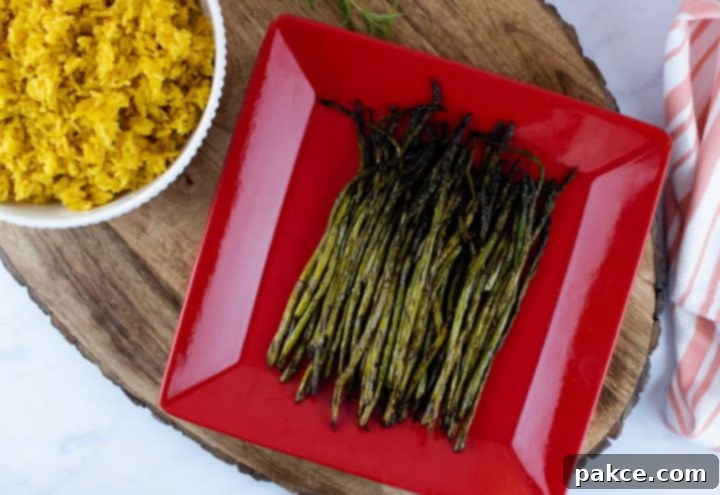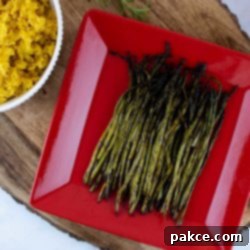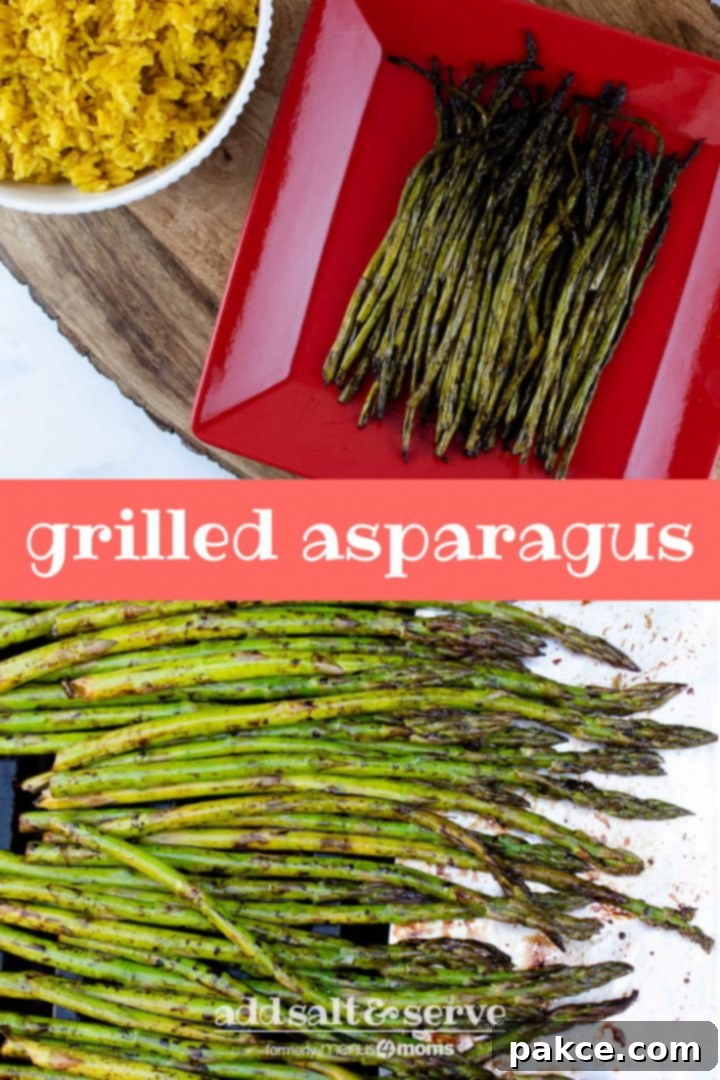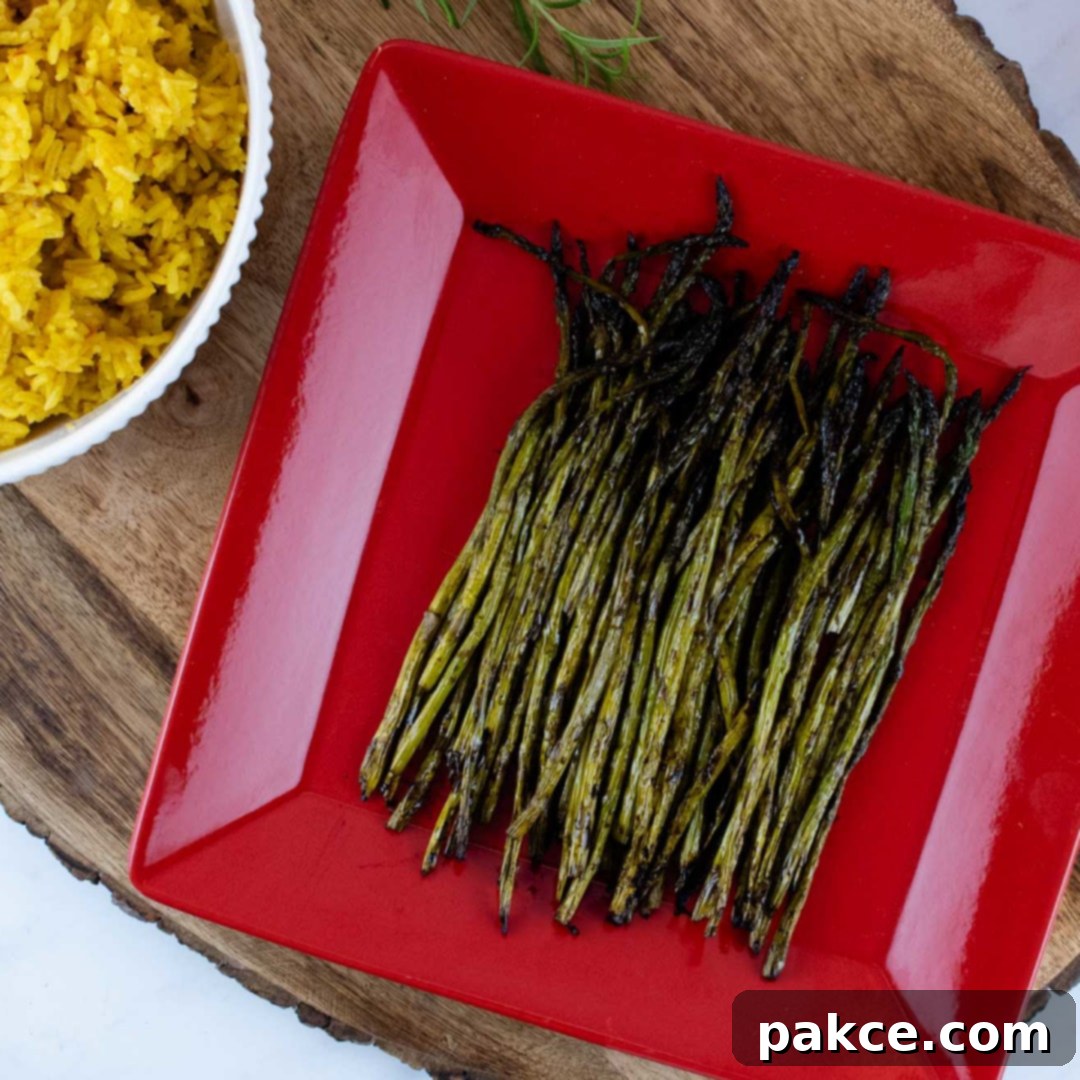Perfect Grilled Asparagus Recipe: A Simple & Delicious Spring Side Dish

There’s something truly magical about the aroma of fresh vegetables hitting a hot grill. Among the stars of spring produce, asparagus shines brightest when kissed by flames. Grilling isn’t just a cooking method; it’s a way to unlock the deep, earthy, and slightly sweet flavors of this slender green stalk. This simple grilled asparagus recipe is a family favorite, cherished for its tender-crisp texture and minimal cleanup – a perfect solution for busy weeknights or relaxed weekend barbecues. Forget about endless pots and pans; grilling means less mess and more time to enjoy your delicious meal.
Asparagus is a quintessential spring vegetable, arriving in abundance as the weather warms. Its delicate flavor and satisfying crunch make it an ideal side dish for almost any main course, from grilled chicken and fish to steaks and even pasta. This particular recipe, featuring a delightful balsamic and olive oil marinade, elevates the natural taste of asparagus, transforming it into an irresistible accompaniment that even the pickiest eaters will love. In fact, for many, it ranks high on the list of favorite vegetable dishes – a true testament to its universal appeal.
Choosing the Best Asparagus for Grilling
The secret to truly outstanding grilled asparagus starts long before it hits the grill: it begins with selecting the freshest, highest-quality stalks. Asparagus is at its peak in early spring, so keep an eye out for vibrant green spears with tight, compact tips. These are indicators of freshness and tenderness.
- Slender vs. Thick Stalks: While thicker stalks might seem more substantial, the truth is that slender stalks (about the thickness of a pencil) are generally more tender and boast a more delicate flavor. Fat stalks, on the other hand, can sometimes be tougher, stringier, and have a more pronounced woody taste, especially towards the base. For grilling, thinner stalks tend to cook more evenly and quickly, achieving that perfect tender-crisp bite without becoming mushy.
- Color and Tips: Always look for stalks that are bright green, almost gleaming. Avoid any that appear dull, yellowish, or have withered ends. The tips should be tightly closed and firm, not splayed or soft.
- Firmness: When gently squeezed, the stalks should feel firm and snap easily, indicating freshness. Limp or rubbery asparagus has lost much of its moisture and will lack the desired crispness after cooking.
- Storage Tips: To keep your fresh asparagus at its best until you’re ready to grill, treat it like a bouquet of flowers. Trim about an inch off the bottom of the stalks, then stand them upright in a glass jar or container with about an inch of water at the bottom. Cover the tips loosely with a plastic bag and store in the refrigerator. This method can keep asparagus fresh and crisp for several days.
Preparing Asparagus: The Snap vs. Peel Debate
Once you’ve selected your perfect bundle of asparagus, proper preparation is key. The first step involves removing the tough, woody ends. There are two primary schools of thought on how to do this:
- The Snap Method: This is my preferred method for its simplicity and efficiency, and it’s less messy. To do this, take one asparagus stalk and hold one end close to the base of the stem. With your other hand, hold the stalk about halfway up its length. Gently bend both ends downward. The stalk will naturally snap at the point where the tough, fibrous part transitions into the tender, edible portion. Repeat this with all your asparagus stalks. While some might argue that this method can waste a small amount of edible asparagus, the ease and speed often outweigh this minor concern, ensuring you get rid of only the truly inedible parts.
- The Trim and Peel Method: Publications like Cook’s Illustrated suggest that trimming and peeling the ends of asparagus is a superior method. This involves trimming about an inch or two off the bottom of the stalk with a knife, then using a vegetable peeler to carefully remove the outer layer of the remaining lower portion of the stalk. The argument here is that it allows you to keep more of the asparagus while still removing any stringiness. While this method can be effective, it is more time-consuming and creates more cleanup in the kitchen. For a quick and easy grilled dish, the snapping method is perfectly adequate and delivers excellent results.
Regardless of your chosen method, after trimming, give your asparagus a good rinse under cold water and pat them thoroughly dry with a clean kitchen towel. Excess moisture can steam the asparagus on the grill, preventing those desirable char marks and crispy edges.
The Simple Marinade: Enhancing Flavor
The beauty of grilled asparagus lies in its ability to be both simple and incredibly flavorful. A basic marinade of olive oil and balsamic vinegar is all you need to elevate this vegetable to new heights.
- Olive Oil: A good quality olive oil serves multiple purposes. Firstly, it helps to coat the asparagus evenly, preventing it from sticking to the grill grates. Secondly, it acts as a flavor carrier, helping the balsamic vinegar and any seasonings adhere to the stalks. Thirdly, the fat in the oil contributes to beautiful charring and caramelization on the grill, enhancing the taste and texture.
- Balsamic Vinegar: This adds a wonderful tangy and slightly sweet complexity that perfectly complements the earthy flavor of asparagus. Its acidity also helps to tenderize the outer layer slightly, allowing for better absorption of flavors and a more even cook. If you don’t have balsamic, lemon juice can be a fantastic alternative, providing a bright, zesty contrast. Red wine vinegar or even a touch of apple cider vinegar could also work, offering slightly different flavor profiles.
- Salt and Pepper: These foundational seasonings are crucial. Coarse sea salt or kosher salt will bring out the natural sweetness of the asparagus, while freshly ground black pepper adds a subtle kick. Don’t be shy with your seasoning, but remember that the flavors will concentrate slightly on the grill.
- Optional Additions: Feel free to customize your marinade. A pinch of garlic powder or fresh minced garlic can add aromatic depth. A touch of onion powder or a sprinkle of red pepper flakes for a hint of heat are also great options. Fresh herbs like thyme or rosemary, finely chopped, can infuse a sophisticated aroma and flavor.
Once coated, allow the asparagus to marinate for about 10 minutes. This short period is enough for the flavors to meld without over-tenderizing the vegetable.
Recipe

Grilled Asparagus
Add to Shopping ListGo to Shopping List
Ingredients
- 1 lb. fresh asparagus
- 2 tablespoon olive oil
- ¼ cup balsamic vinegar, or to taste
Instructions
-
Wash asparagus and snap tough ends off.
-
Drizzle with olive oil and balsamic vinegar and marinate for 10 minutes.
-
In order to keep the tips from burning, place a piece of foil under just the tip ends of the asparagus on the grill. Grill until tender, turning regularly, and serve immediately.
Notes
Nutrition per serving
Share
Pin
Grilling Techniques for Perfectly Tender Asparagus
Grilling asparagus is a straightforward process, but a few techniques can ensure perfect results every time.
- Preheat Your Grill: Always start with a clean, preheated grill. Medium-high heat is ideal for asparagus, allowing it to cook quickly and develop those sought-after char marks without becoming limp. A temperature around 400-450°F (200-230°C) is a good target.
- Direct Heat is Best: For thin vegetables like asparagus, direct grilling over the flame is the way to go. This ensures quick cooking and a smoky flavor.
- The Foil Tip for Even Cooking: Asparagus tips are notoriously delicate and can burn quickly due to their thinness compared to the rest of the stalk. To prevent this, a clever trick is to place a small piece of aluminum foil directly under just the tip ends of the asparagus on the grill. This shields them from direct, intense heat while the thicker parts of the stalks cook to tender perfection. You can remove the foil for the last minute or two if you desire a slight char on the tips.
- Grill Time and Turning: The cooking time for grilled asparagus is relatively short, usually 5-10 minutes, depending on the thickness of the stalks and your desired tenderness. Turn the asparagus regularly with tongs to ensure even cooking and beautiful charring on all sides. You’re looking for bright green stalks with tender-crisp texture and noticeable grill marks.
- Doneness Test: Asparagus is done when it’s bright green, slightly tender when pierced with a fork, but still retains a bit of a bite. Overcooked asparagus becomes dull green and limp.
Broiling Asparagus: An Indoor Alternative
No outdoor grill? No problem! This delicious asparagus recipe can also be successfully prepared under a broiler, offering a similar char and tender texture.
- Preparation: Follow the same steps for washing, snapping, and marinating the asparagus with olive oil and balsamic vinegar.
- Broiler Setup: Preheat your broiler to high. Line a baking sheet with foil for easy cleanup. Arrange the marinated asparagus in a single layer on the prepared baking sheet.
- The Foil Trick (Reversed): When broiling, the heat comes from above, so you’ll reverse the foil trick. Place a piece of foil *on top* of the asparagus tips to shield them from the intense direct heat. This will prevent them from burning before the thicker stalks are cooked.
- Broiling Time: Place the baking sheet about 4-6 inches from the broiler element. Broil for 5-10 minutes, turning the asparagus halfway through. Keep a close eye on it, as broilers can cook very quickly! The asparagus should be tender-crisp with some browned, slightly charred spots. Remove the foil from the tips for the last minute if you want to achieve some char there.
Serving Suggestions & Flavor Variations
Grilled asparagus is incredibly versatile and pairs well with a wide array of dishes. Here are a few ideas to inspire your next meal:
- Classic Pairings: Serve it alongside grilled salmon, steak, chicken breast, or pork chops for a complete and healthy meal.
- Brunch Delight: Add a side of grilled asparagus to your eggs Benedict or a frittata for an elegant touch.
- Pasta & Salads: Chop the grilled asparagus and toss it into a fresh spring pasta dish or a hearty grain salad.
-
Garnishes for Extra Flair:
- Lemon Zest: A grating of fresh lemon zest just before serving adds a bright, aromatic lift.
- Parmesan Cheese: Shavings of Parmesan or a sprinkle of grated Parmesan add a salty, umami kick that complements the asparagus beautifully.
- Toasted Nuts: A scattering of toasted pine nuts or slivered almonds provides a lovely crunch.
- Flaky Sea Salt: A final sprinkle of flaky sea salt can enhance the texture and intensify the flavors.
- Drizzles: A finishing drizzle of extra virgin olive oil or a balsamic glaze can add richness and a touch of sweetness.
- Experiment with Seasonings: Don’t limit yourself to balsamic. Try a different flavored oil (like lemon-infused olive oil), a splash of soy sauce, or a sprinkle of your favorite herb blend. A touch of smoked paprika or chili powder can also add an exciting dimension.
Health Benefits of Asparagus
Beyond its delicious taste and ease of preparation, asparagus is a nutritional powerhouse, making it an excellent choice for a healthy diet.
- Rich in Vitamins: Asparagus is an excellent source of Vitamin K, crucial for blood clotting and bone health. It also provides significant amounts of Vitamin A (important for vision and immune function), Vitamin C (an antioxidant and immune booster), and Folate (essential for cell growth and DNA formation).
- Antioxidants: It’s packed with various antioxidants, including flavonoids, anthocyanins, and polyphenols, which help fight free radicals in the body, reducing oxidative stress and inflammation.
- Fiber Content: A good source of dietary fiber, asparagus aids in digestion, promotes gut health, and can contribute to feelings of fullness, which is beneficial for weight management.
- Low in Calories: Asparagus is very low in calories, making it a guilt-free addition to any meal.
- Diuretic Properties: Historically, asparagus has been recognized for its natural diuretic properties, which can help flush excess fluids from the body.
Conclusion: Your Go-To Spring Side
Grilling asparagus transforms a simple vegetable into a tender, flavorful, and slightly smoky treat that is incredibly easy to prepare. Whether you’re a seasoned grill master or a novice cook, this recipe offers a foolproof way to enjoy one of spring’s finest offerings. Its adaptability, quick cooking time, and fantastic health benefits make it a perfect addition to any meal. So fire up your grill, grab a bunch of fresh asparagus, and get ready to enjoy a truly delightful side dish that promises both flavor and convenience.
Pin this recipe and share your creations with us!

